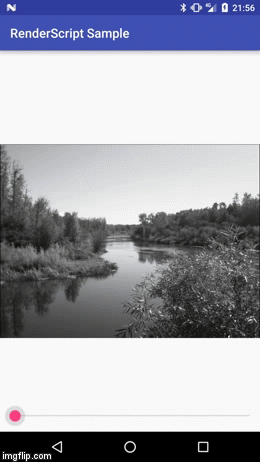
RenderScript is a framework to allow high performance parallel computation on Android. Scripts you write will be executed across all available processors (e.g. CPU, GPU etc) in parallel allowing you to focus on the task you want to achieve instead of how it is scheduled and executed.
Scripts are written in a C99 based language (C99 being an old version of the C programming language standard). For each Script a Java class is created which allows you to easily interact with RenderScript in your Java code.
There exist two different ways to access RenderScript in your app, with the Android Framework libraries or the Support Library. Even if you don’t want to target devices before API level 11 you should always use the Support Library implementation because it ensures devices compatibility across many different devices. To use the support library implementation you need to use at least build tools version 18.1.0!
Now lets setup the build.gradle file of your application:
android {
compileSdkVersion 24
buildToolsVersion '24.0.1'
defaultConfig {
minSdkVersion 8
targetSdkVersion 24
renderscriptTargetApi 18
renderscriptSupportModeEnabled true
}
}
renderscriptTargetApi: This should be set to the version earliest API level which provides all RenderScript functionality you require.renderscriptSupportModeEnabled: This enables the use of the Support Library RenderScript implementation.A typical RenderScript consists of two things: Kernels and Functions. A function is just what it sounds like - it accepts an input, does something with that input and returns an output. A Kernel is where the real power of RenderScript comes from.
A Kernel is a function which is executed against every element inside an Allocation. An Allocation can be used to pass data like a Bitmap or a byte array to a RenderScript and they are also used to get a result from a Kernel. Kernels can either take one Allocation as input and another as output or they can modify the data inside just one Allocation.
You can write your one Kernels, but there are also many predefined Kernels which you can use to perform common operations like a Gaussian Image Blur.
As already mentioned for every RenderScript file a class is generated to interact with it. These classes always start with the prefix ScriptC_ followed by the name of the RenderScript file. For example if your RenderScript file is called example then the generated Java class will be called ScriptC_example. All predefined Scripts just start with the prefix Script - for example the Gaussian Image Blur Script is called ScriptIntrinsicBlur.
The following example is based on an example on GitHub. It performs basic image manipulation by modifying the saturation of an image. You can find the source code here and check it out if you want to play around with it yourself. Here’s a quick gif of what the result is supposed to look like:

demo picture
RenderScript files reside in the folder src/main/rs in your project. Each file has the file extension .rs and has to contain two #pragma statements at the top:
#pragma version(1)
#pragma rs java_package_name(your.package.name)